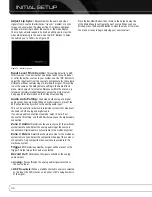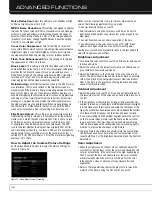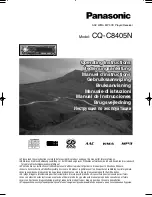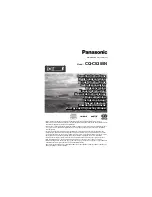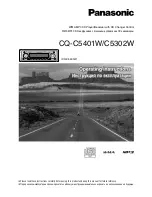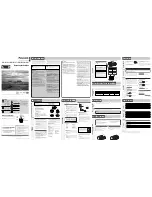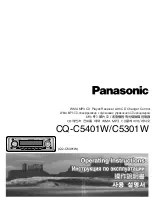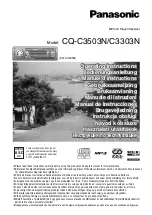
40
ADVANCED FUNCTIONS
Much of the AVR 7550HD’s performance is handled automatically,
with little intervention required on your part. The AVR 7550HD is
capable of being customized to suit your system and your tastes.
In this section, some of the more advanced adjustments available
are described.
AUDIO PROCESSING AND SURROUND
SOUND
Audio signals output by sources are encoded in a variety of formats
that can affect not only the quality of the sound but the number of
speaker channels and the surround mode. You may also manually
select a different surround mode, when available.
Analog Audio Signals
Analog audio signals usually consist of two channels – left and
right. The AVR 7550HD offers three options for playback:
1.
Analog Bypass Mode:
The 2-channel signal is passed
directly from the input to the volume control, without being
digitized or undergoing any processing for bass management
or surround sound. To select analog bypass mode:
a) The analog audio inputs for the source must be selected. If
necessary, press the Info Button on the remote and use the
1
/
5
Buttons to scroll to the Audio Input from source setting.
b) The tone controls must be disabled by setting the Tone Control
to Off. Press the Audio Effects Button to access the Tone
Control setting.
c) The 2-channel Stereo mode must be selected. Press the
Surround Modes Button to access the STEREO line of the
Surround Modes submenu. Press the OK Button to select
2-channel Stereo.
When the Tone Control setting is Off, the front speakers will
be set to Large automatically. When the Tone Control setting
is turned On, if you have set the front speaker crossover to
a numeric setting, the front speakers will return to the Small
setting.
NOTE:
Audio from The Bridge II source is analog, and when
2-channel Stereo mode is selected, the audio will be played in
Analog Bypass mode.
2.
DSP Surround Off Mode:
The DSP Surround Off mode
digitizes the incoming signal and applies the bass management
settings, including speaker configuration, delay times and output
levels. Select this mode when your front speakers are small,
limited-range satellites and you are using a subwoofer. To select
this mode, use a digital audio input, or turn the Tone Control
setting off, and select 2-channel Stereo mode.
3.
Analog Surround Modes:
The AVR 7550HD is able to
process 2-channel audio signals to produce multichannel sur-
round sound, even when no surround sound has been encoded
in the recording. Among the available modes are the Dolby
Pro Logic II/IIx modes, the Dolby Virtual Speaker modes, the
DTS Neo:6 modes, the Logic 7 modes and the Stereo modes.
Digital Audio Signals
Digital audio signals offer greater capacity, which allows the
encoding of center and surround channel information directly
into the signal. The result is improved sound quality and startling
directionality, since each channel is reproduced discretely.
Even when only two channels are encoded, the digital signal
allows for a higher sampling rate that delivers greater detail.
High-resolution recordings sound extraordinarily distortion-free,
especially at high frequencies.
Surround Modes
Surround mode selection is dependent upon the format of the
incoming audio signal, as well as personal taste. Table A13 offers a
brief description of each mode and indicates the types of incoming
signals or digital bitstreams the mode may be used with. Additional
information about the Dolby and DTS modes is available on the
companies’ Web sites: www.dolby.com and www.dtsonline.com.
When in doubt, check the jacket of your disc for more information
on which surround modes are available. Usually, nonessential
sections of the disc, such as trailers, extra materials or the disc
menu, are only available in Dolby Digital 2.0 (2-channel) or PCM
2-channel mode. If the main title is playing and the display shows
one of these surround modes, look for an audio or language setup
section in the disc’s menu. Also, make sure your player’s audio
output is set to the original bitstream rather than 2-channel PCM.
Stop play and check the player’s output setting.
For any incoming signal, only a limited number of surround
modes are available. Although there is never a time when all of
the AVR 7550HD’s surround modes are available, there is usually
a wide variety of modes available for a given input.
Multichannel digital recordings are found in the 5.1-, 6.1- or 7.1-
channel formats. The channels included in a 5.1-channel recording
are front left, front right, center, surround left, surround right and
LFE. The LFE channel is denoted as “.1” to represent the fact that
it is limited to the low frequencies.
6.1-Channel recordings add a single surround back channel, and
7.1-channel recordings add surround back left and surround back
right channels to the 5.1-channel configuration. New formats are
available in 7.1-channel configurations. The AVR 7550HD is able to
play the new audio formats, delivering a more exciting home theater
experience.
NOTE:
To use the 6.1- and 7.1-channel surround modes,
the Surround Back channels must be enabled. See the Manual
Speaker Setup section on page 41 for more information.
The Digital formats are Dolby Digital 2.0 (two channels only), Dolby
Digital 5.1, Dolby Digital EX (6.1), Dolby Digital Plus (7.1), Dolby
TrueHD (7.1), DTS-HD High-Resolution Audio (7.1), DTS-HD Master
Audio (7.1), DTS 5.1, DTS-ES (6.1 Matrix and Discrete), DTS 96/24
(5.1), 2-channel PCM modes in 32kHz, 44.1kHz, 48kHz or 96kHz,
and 5.1 or 7.1 multichannel PCM.
When a digital signal is received, the AVR 7550HD detects the
encoding method and the number of channels, which is displayed
briefly as three numbers, separated by slashes (e.g., “3/2/.1”).
AVR 7550HD OM.qxd 2/25/09 11:52 AM Page 40







